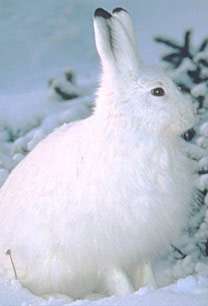Field Guide/Mammals/Snowshoe Hare
< Field Guide < Mammals| Lepus americanus (Snowshoe Hare) | |
|---|---|
|
Family: Leporidae
Size: Total length: 20 in. (508 mm.). Tail Length: 2 in. (50.8 mm.). Weight: 3 lbs. (1.36 kg). [1]
Description: The Snowshoe Hare is a medium-sized rabbit. It has a brown coat in the summer, and a white coat during the winter. [1]
The soles of its hind legs are densely furred and large, forming the characteristic snowshoe. [2]
Similar Species: The Snowshoe Hare is similar to but slightly taller than the Eastern Cottontail Rabbit (Sylvilagus floridanus).[1]
Range: Northern species found as far north as Alaska and over most of Canada. [1]
Diet: Grass, clover, and ferns in the summer. Bark and twigs in the winter. [1]
Also eat their own feces. [2]
Activity: Nocturnal. [3]
Most active during dawn and dusk during periods of low light. Sleep and groom throughout the day. [2]
Reproduction: Mates in February through July. Gestation period of 36 days. Typical litter size of 4 (3-4 litters per year). [1]
Weaned at 14-28 days. Polygynandrous (males and females both have multiple mates). [2]
Lifespan: 5 years in the wild. Up to 85% do not live longer than 1 year. [2]
Notes: Much of the Snowshoe Hare’s digestion occurs in the hindgut. Therefore, to extract all of the available nutrients they will often eat their own feces to cycle their food through a second time. The Snowshoe Hare can run up to 27 MPH and leap 10 ft. in a single bound. [2]
Common predators include Coyotes (Canis latrans) Lynxes (Lynx lynx), Snowy Owls (Bubo scandiacus), and Red-Tailed Hawks (Butao jamaicensis). [1] Snowshow Hare’s are accomplished swimmers and often swim to escape prey (2). Snowshoe Hares have very dramatic population fluctuations over 10-year cycles thought to be accredited to over-grazing. Females are typically larger than males. [4] |
 Snowshoe Hare Lepus americanus |
References
- 1 2 3 4 5 6 7 8 Minnesota Department of Natural Resources (2012), Lepus americanus
- 1 2 3 4 5 6 7 Shefferly, N. (2007), Lepus americanus
- ↑ Smithsonian National Museum of Natural History (2012), Lepus americanus
- ↑ Ruland, C. (2012), Lepus americanus
This article is issued from Wikibooks. The text is licensed under Creative Commons - Attribution - Sharealike. Additional terms may apply for the media files.